Financial Performance Analysis of Amazon: Key Ratios and Strategies
VerifiedAdded on 2021/05/31
|17
|3643
|37
Report
AI Summary
This report provides a comprehensive financial analysis of Amazon, examining its performance in 1999 and 2000. It analyzes the income statement, balance sheet, and cash flow statement, highlighting key trends in revenue, expenses, and cash flow. The report calculates and interprets key financial ratios, including profitability, liquidity, efficiency, and solvency ratios, to assess Amazon's financial health. It identifies critical success and failure factors, such as competition and market conditions, and discusses the impact of the political and competitive environment. The report also addresses ethical considerations during insolvency and provides recommendations for investors, emphasizing the need for strategic adjustments, including exploring new business models and managing debt. The analysis underscores the importance of adapting to market dynamics and maintaining a strong financial position for long-term success.
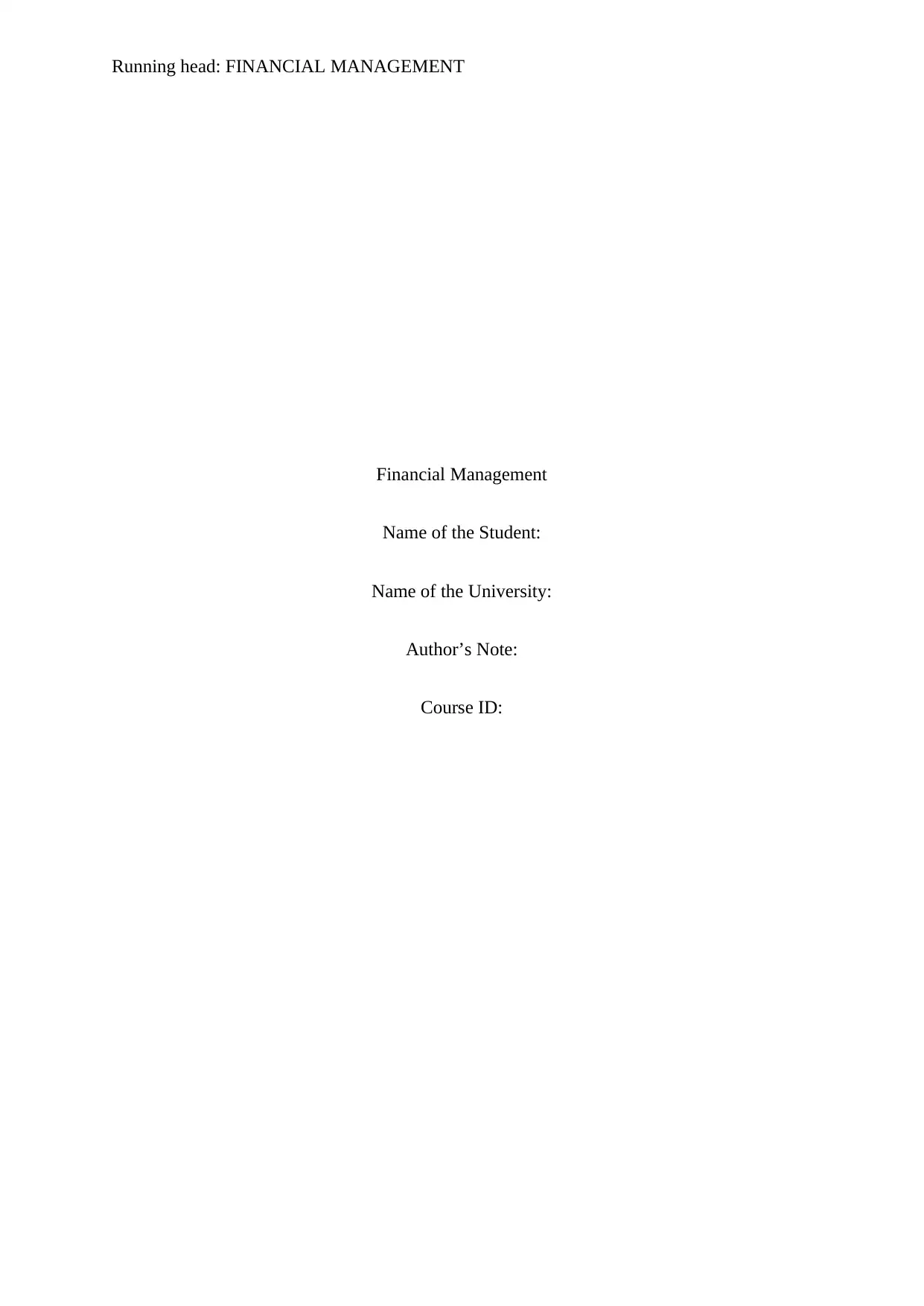
Running head: FINANCIAL MANAGEMENT
Financial Management
Name of the Student:
Name of the University:
Author’s Note:
Course ID:
Financial Management
Name of the Student:
Name of the University:
Author’s Note:
Course ID:
Paraphrase This Document
Need a fresh take? Get an instant paraphrase of this document with our AI Paraphraser
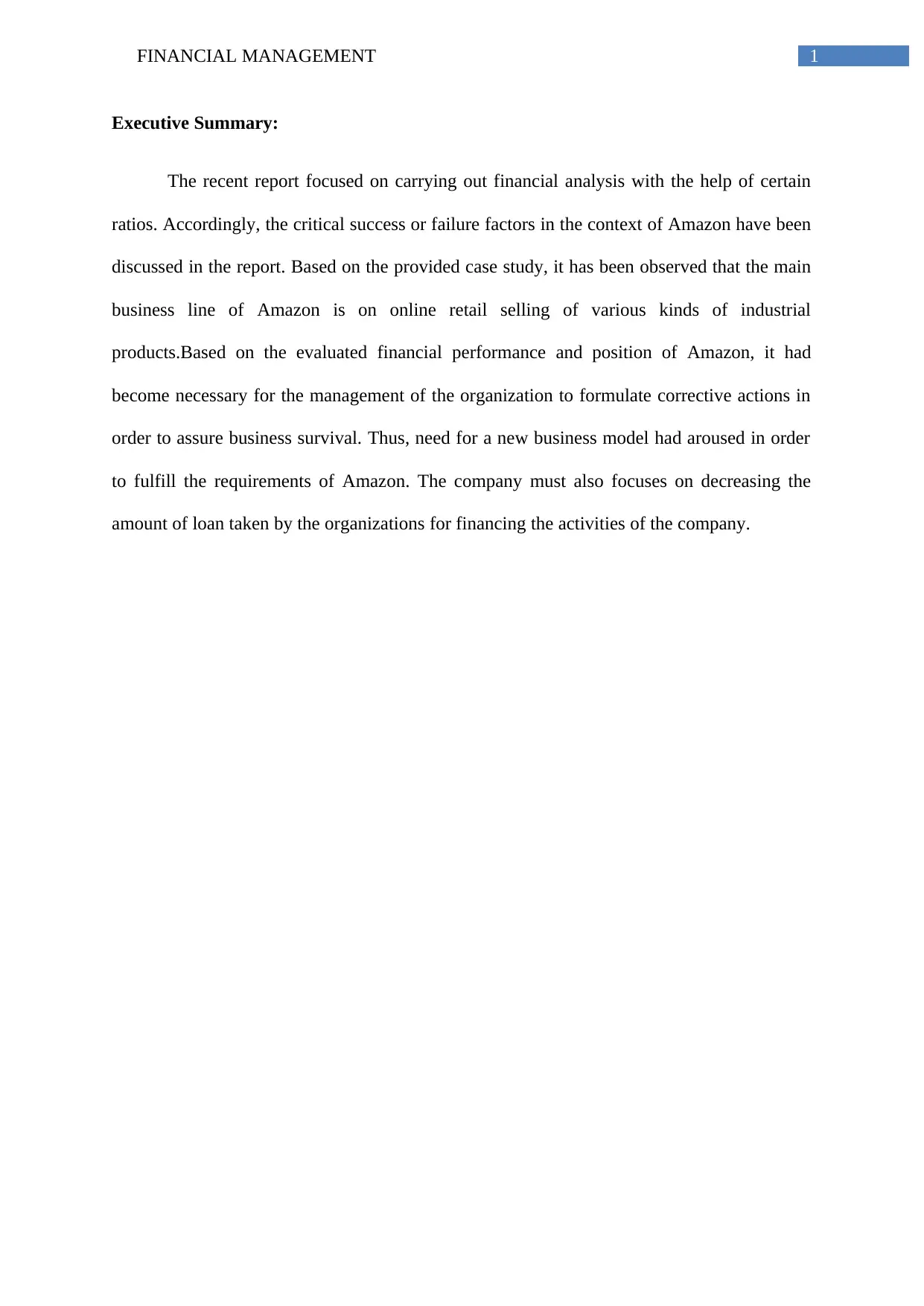
1FINANCIAL MANAGEMENT
Executive Summary:
The recent report focused on carrying out financial analysis with the help of certain
ratios. Accordingly, the critical success or failure factors in the context of Amazon have been
discussed in the report. Based on the provided case study, it has been observed that the main
business line of Amazon is on online retail selling of various kinds of industrial
products.Based on the evaluated financial performance and position of Amazon, it had
become necessary for the management of the organization to formulate corrective actions in
order to assure business survival. Thus, need for a new business model had aroused in order
to fulfill the requirements of Amazon. The company must also focuses on decreasing the
amount of loan taken by the organizations for financing the activities of the company.
Executive Summary:
The recent report focused on carrying out financial analysis with the help of certain
ratios. Accordingly, the critical success or failure factors in the context of Amazon have been
discussed in the report. Based on the provided case study, it has been observed that the main
business line of Amazon is on online retail selling of various kinds of industrial
products.Based on the evaluated financial performance and position of Amazon, it had
become necessary for the management of the organization to formulate corrective actions in
order to assure business survival. Thus, need for a new business model had aroused in order
to fulfill the requirements of Amazon. The company must also focuses on decreasing the
amount of loan taken by the organizations for financing the activities of the company.
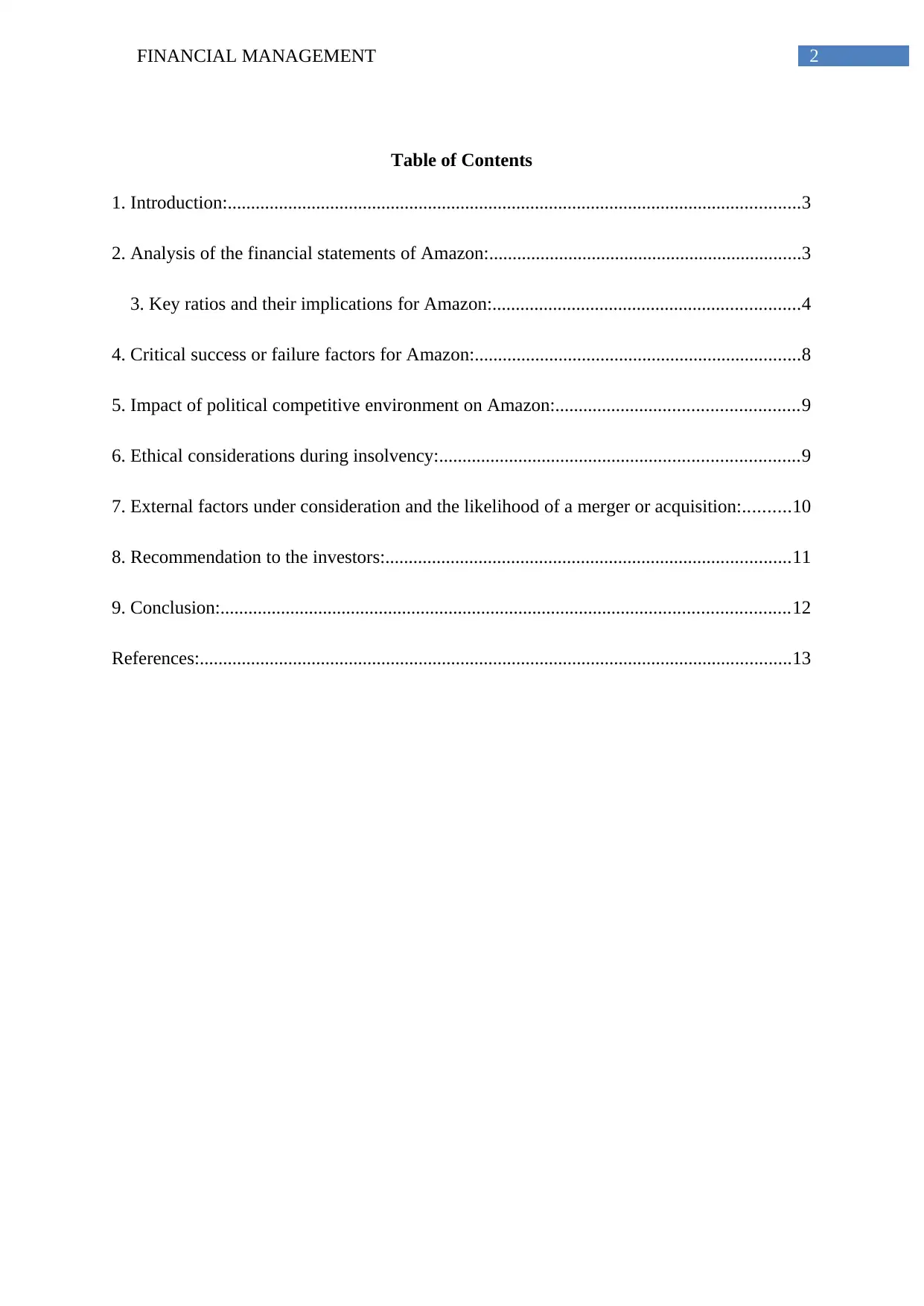
2FINANCIAL MANAGEMENT
Table of Contents
1. Introduction:...........................................................................................................................3
2. Analysis of the financial statements of Amazon:...................................................................3
3. Key ratios and their implications for Amazon:..................................................................4
4. Critical success or failure factors for Amazon:......................................................................8
5. Impact of political competitive environment on Amazon:....................................................9
6. Ethical considerations during insolvency:.............................................................................9
7. External factors under consideration and the likelihood of a merger or acquisition:..........10
8. Recommendation to the investors:.......................................................................................11
9. Conclusion:..........................................................................................................................12
References:...............................................................................................................................13
Table of Contents
1. Introduction:...........................................................................................................................3
2. Analysis of the financial statements of Amazon:...................................................................3
3. Key ratios and their implications for Amazon:..................................................................4
4. Critical success or failure factors for Amazon:......................................................................8
5. Impact of political competitive environment on Amazon:....................................................9
6. Ethical considerations during insolvency:.............................................................................9
7. External factors under consideration and the likelihood of a merger or acquisition:..........10
8. Recommendation to the investors:.......................................................................................11
9. Conclusion:..........................................................................................................................12
References:...............................................................................................................................13
⊘ This is a preview!⊘
Do you want full access?
Subscribe today to unlock all pages.

Trusted by 1+ million students worldwide
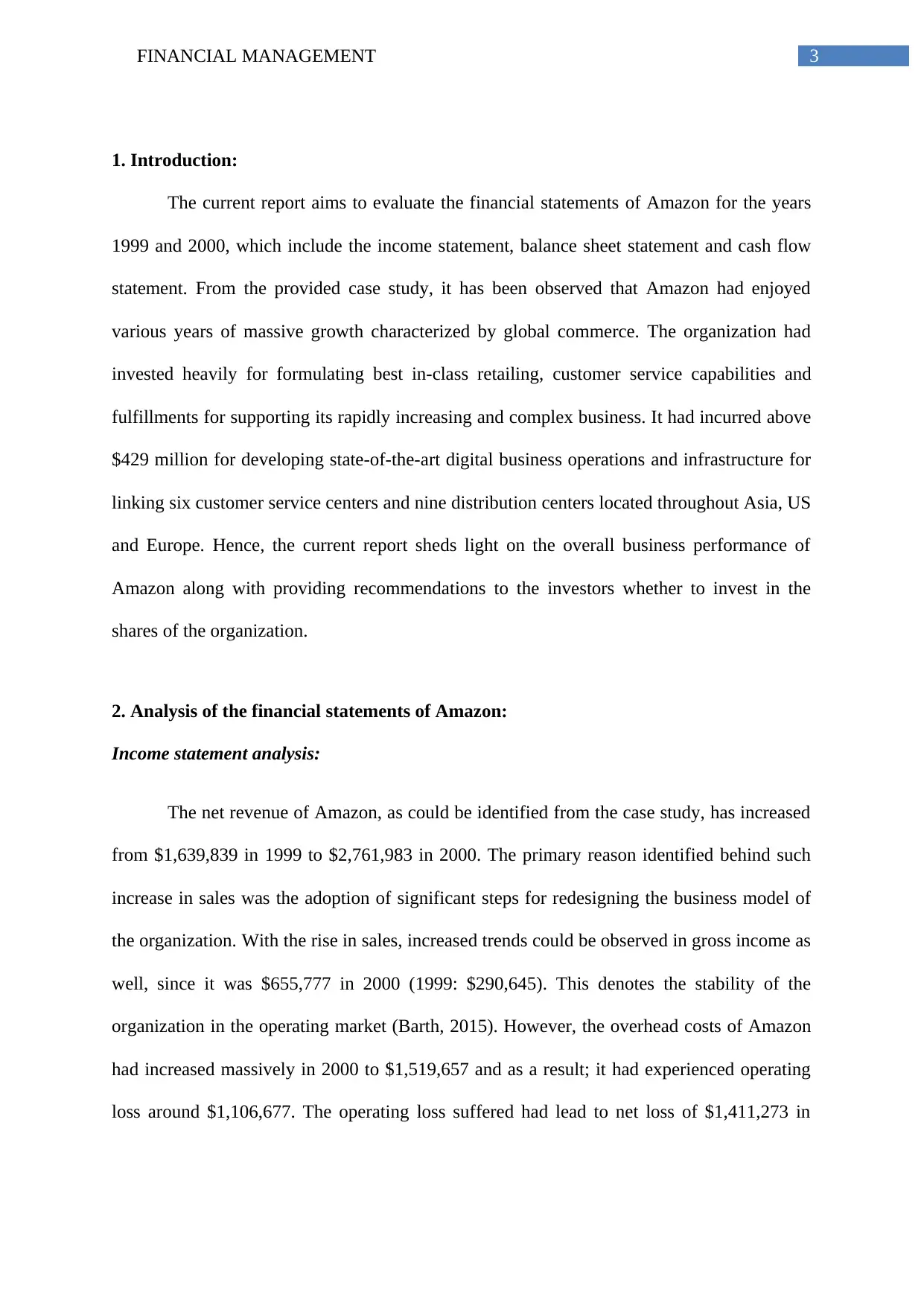
3FINANCIAL MANAGEMENT
1. Introduction:
The current report aims to evaluate the financial statements of Amazon for the years
1999 and 2000, which include the income statement, balance sheet statement and cash flow
statement. From the provided case study, it has been observed that Amazon had enjoyed
various years of massive growth characterized by global commerce. The organization had
invested heavily for formulating best in-class retailing, customer service capabilities and
fulfillments for supporting its rapidly increasing and complex business. It had incurred above
$429 million for developing state-of-the-art digital business operations and infrastructure for
linking six customer service centers and nine distribution centers located throughout Asia, US
and Europe. Hence, the current report sheds light on the overall business performance of
Amazon along with providing recommendations to the investors whether to invest in the
shares of the organization.
2. Analysis of the financial statements of Amazon:
Income statement analysis:
The net revenue of Amazon, as could be identified from the case study, has increased
from $1,639,839 in 1999 to $2,761,983 in 2000. The primary reason identified behind such
increase in sales was the adoption of significant steps for redesigning the business model of
the organization. With the rise in sales, increased trends could be observed in gross income as
well, since it was $655,777 in 2000 (1999: $290,645). This denotes the stability of the
organization in the operating market (Barth, 2015). However, the overhead costs of Amazon
had increased massively in 2000 to $1,519,657 and as a result; it had experienced operating
loss around $1,106,677. The operating loss suffered had lead to net loss of $1,411,273 in
1. Introduction:
The current report aims to evaluate the financial statements of Amazon for the years
1999 and 2000, which include the income statement, balance sheet statement and cash flow
statement. From the provided case study, it has been observed that Amazon had enjoyed
various years of massive growth characterized by global commerce. The organization had
invested heavily for formulating best in-class retailing, customer service capabilities and
fulfillments for supporting its rapidly increasing and complex business. It had incurred above
$429 million for developing state-of-the-art digital business operations and infrastructure for
linking six customer service centers and nine distribution centers located throughout Asia, US
and Europe. Hence, the current report sheds light on the overall business performance of
Amazon along with providing recommendations to the investors whether to invest in the
shares of the organization.
2. Analysis of the financial statements of Amazon:
Income statement analysis:
The net revenue of Amazon, as could be identified from the case study, has increased
from $1,639,839 in 1999 to $2,761,983 in 2000. The primary reason identified behind such
increase in sales was the adoption of significant steps for redesigning the business model of
the organization. With the rise in sales, increased trends could be observed in gross income as
well, since it was $655,777 in 2000 (1999: $290,645). This denotes the stability of the
organization in the operating market (Barth, 2015). However, the overhead costs of Amazon
had increased massively in 2000 to $1,519,657 and as a result; it had experienced operating
loss around $1,106,677. The operating loss suffered had lead to net loss of $1,411,273 in
Paraphrase This Document
Need a fresh take? Get an instant paraphrase of this document with our AI Paraphraser
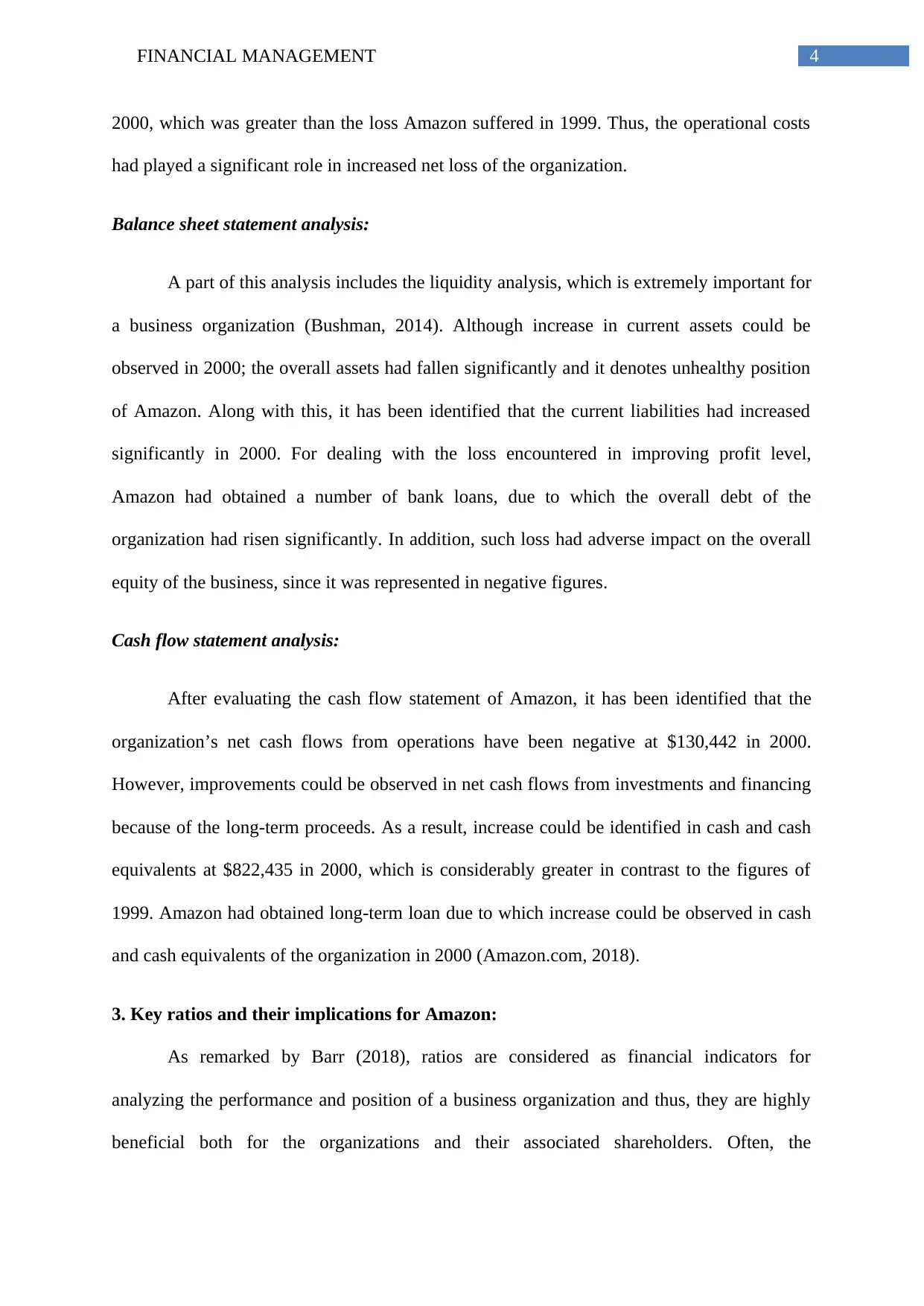
4FINANCIAL MANAGEMENT
2000, which was greater than the loss Amazon suffered in 1999. Thus, the operational costs
had played a significant role in increased net loss of the organization.
Balance sheet statement analysis:
A part of this analysis includes the liquidity analysis, which is extremely important for
a business organization (Bushman, 2014). Although increase in current assets could be
observed in 2000; the overall assets had fallen significantly and it denotes unhealthy position
of Amazon. Along with this, it has been identified that the current liabilities had increased
significantly in 2000. For dealing with the loss encountered in improving profit level,
Amazon had obtained a number of bank loans, due to which the overall debt of the
organization had risen significantly. In addition, such loss had adverse impact on the overall
equity of the business, since it was represented in negative figures.
Cash flow statement analysis:
After evaluating the cash flow statement of Amazon, it has been identified that the
organization’s net cash flows from operations have been negative at $130,442 in 2000.
However, improvements could be observed in net cash flows from investments and financing
because of the long-term proceeds. As a result, increase could be identified in cash and cash
equivalents at $822,435 in 2000, which is considerably greater in contrast to the figures of
1999. Amazon had obtained long-term loan due to which increase could be observed in cash
and cash equivalents of the organization in 2000 (Amazon.com, 2018).
3. Key ratios and their implications for Amazon:
As remarked by Barr (2018), ratios are considered as financial indicators for
analyzing the performance and position of a business organization and thus, they are highly
beneficial both for the organizations and their associated shareholders. Often, the
2000, which was greater than the loss Amazon suffered in 1999. Thus, the operational costs
had played a significant role in increased net loss of the organization.
Balance sheet statement analysis:
A part of this analysis includes the liquidity analysis, which is extremely important for
a business organization (Bushman, 2014). Although increase in current assets could be
observed in 2000; the overall assets had fallen significantly and it denotes unhealthy position
of Amazon. Along with this, it has been identified that the current liabilities had increased
significantly in 2000. For dealing with the loss encountered in improving profit level,
Amazon had obtained a number of bank loans, due to which the overall debt of the
organization had risen significantly. In addition, such loss had adverse impact on the overall
equity of the business, since it was represented in negative figures.
Cash flow statement analysis:
After evaluating the cash flow statement of Amazon, it has been identified that the
organization’s net cash flows from operations have been negative at $130,442 in 2000.
However, improvements could be observed in net cash flows from investments and financing
because of the long-term proceeds. As a result, increase could be identified in cash and cash
equivalents at $822,435 in 2000, which is considerably greater in contrast to the figures of
1999. Amazon had obtained long-term loan due to which increase could be observed in cash
and cash equivalents of the organization in 2000 (Amazon.com, 2018).
3. Key ratios and their implications for Amazon:
As remarked by Barr (2018), ratios are considered as financial indicators for
analyzing the performance and position of a business organization and thus, they are highly
beneficial both for the organizations and their associated shareholders. Often, the
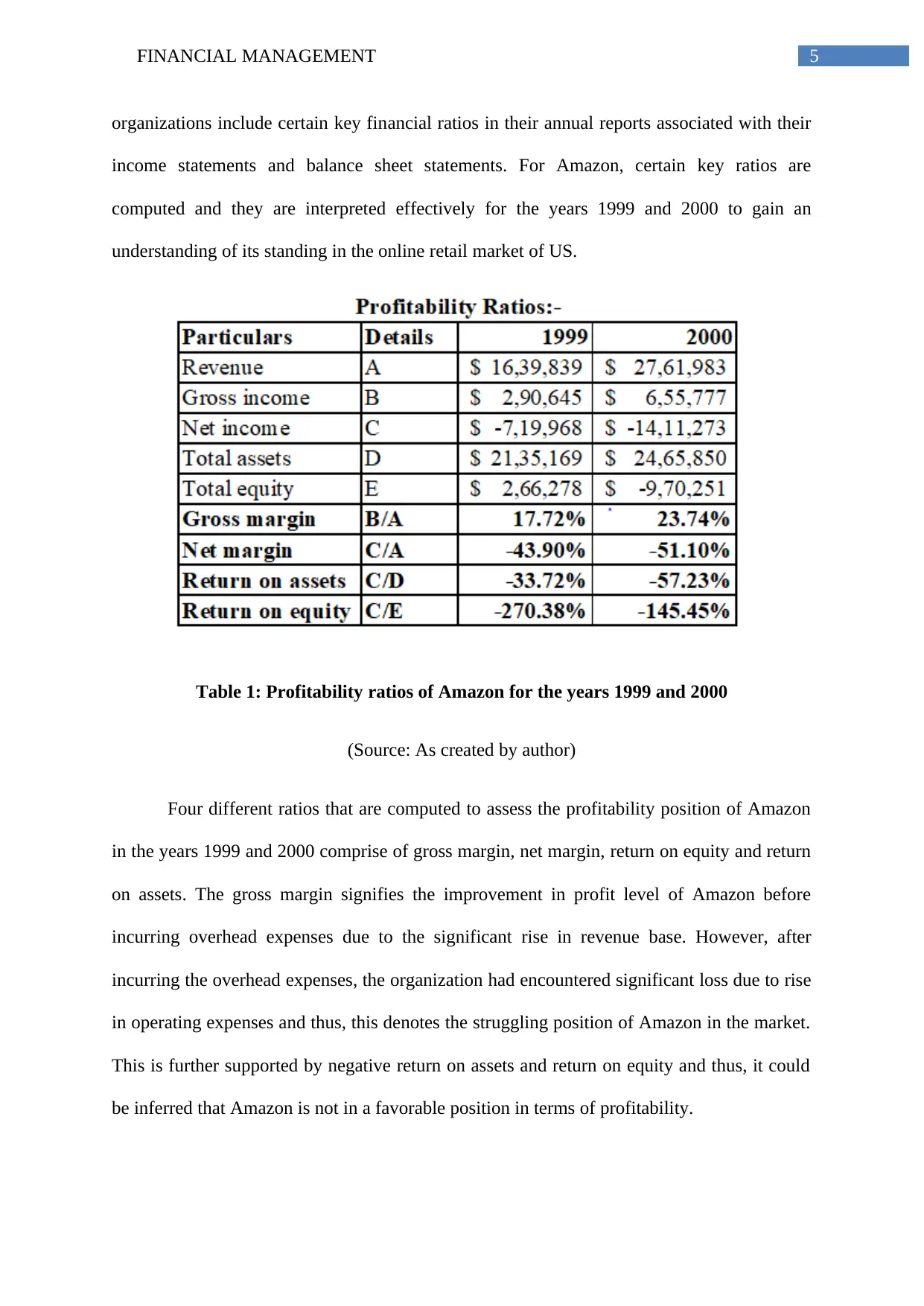
5FINANCIAL MANAGEMENT
organizations include certain key financial ratios in their annual reports associated with their
income statements and balance sheet statements. For Amazon, certain key ratios are
computed and they are interpreted effectively for the years 1999 and 2000 to gain an
understanding of its standing in the online retail market of US.
Table 1: Profitability ratios of Amazon for the years 1999 and 2000
(Source: As created by author)
Four different ratios that are computed to assess the profitability position of Amazon
in the years 1999 and 2000 comprise of gross margin, net margin, return on equity and return
on assets. The gross margin signifies the improvement in profit level of Amazon before
incurring overhead expenses due to the significant rise in revenue base. However, after
incurring the overhead expenses, the organization had encountered significant loss due to rise
in operating expenses and thus, this denotes the struggling position of Amazon in the market.
This is further supported by negative return on assets and return on equity and thus, it could
be inferred that Amazon is not in a favorable position in terms of profitability.
organizations include certain key financial ratios in their annual reports associated with their
income statements and balance sheet statements. For Amazon, certain key ratios are
computed and they are interpreted effectively for the years 1999 and 2000 to gain an
understanding of its standing in the online retail market of US.
Table 1: Profitability ratios of Amazon for the years 1999 and 2000
(Source: As created by author)
Four different ratios that are computed to assess the profitability position of Amazon
in the years 1999 and 2000 comprise of gross margin, net margin, return on equity and return
on assets. The gross margin signifies the improvement in profit level of Amazon before
incurring overhead expenses due to the significant rise in revenue base. However, after
incurring the overhead expenses, the organization had encountered significant loss due to rise
in operating expenses and thus, this denotes the struggling position of Amazon in the market.
This is further supported by negative return on assets and return on equity and thus, it could
be inferred that Amazon is not in a favorable position in terms of profitability.
⊘ This is a preview!⊘
Do you want full access?
Subscribe today to unlock all pages.

Trusted by 1+ million students worldwide
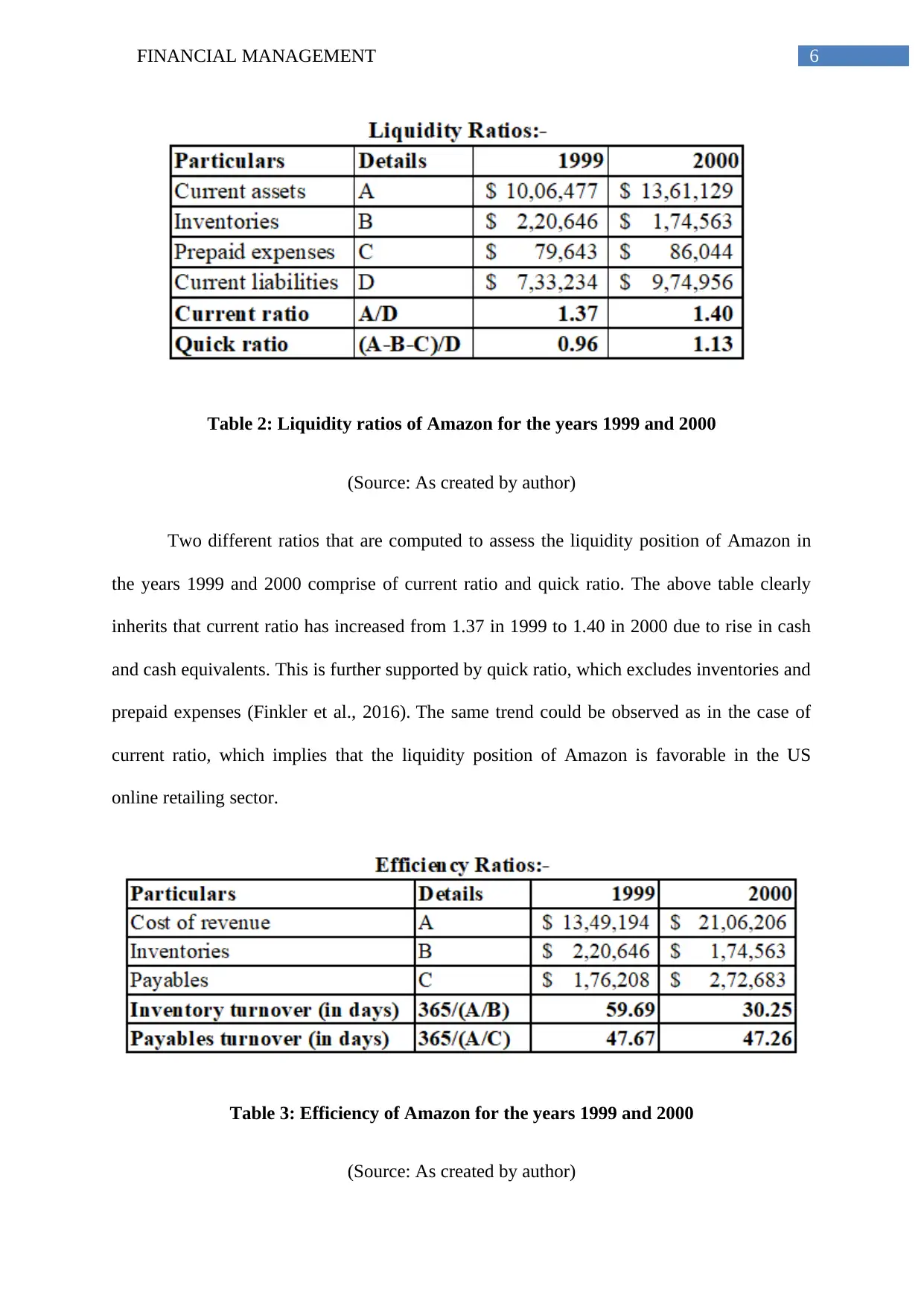
6FINANCIAL MANAGEMENT
Table 2: Liquidity ratios of Amazon for the years 1999 and 2000
(Source: As created by author)
Two different ratios that are computed to assess the liquidity position of Amazon in
the years 1999 and 2000 comprise of current ratio and quick ratio. The above table clearly
inherits that current ratio has increased from 1.37 in 1999 to 1.40 in 2000 due to rise in cash
and cash equivalents. This is further supported by quick ratio, which excludes inventories and
prepaid expenses (Finkler et al., 2016). The same trend could be observed as in the case of
current ratio, which implies that the liquidity position of Amazon is favorable in the US
online retailing sector.
Table 3: Efficiency of Amazon for the years 1999 and 2000
(Source: As created by author)
Table 2: Liquidity ratios of Amazon for the years 1999 and 2000
(Source: As created by author)
Two different ratios that are computed to assess the liquidity position of Amazon in
the years 1999 and 2000 comprise of current ratio and quick ratio. The above table clearly
inherits that current ratio has increased from 1.37 in 1999 to 1.40 in 2000 due to rise in cash
and cash equivalents. This is further supported by quick ratio, which excludes inventories and
prepaid expenses (Finkler et al., 2016). The same trend could be observed as in the case of
current ratio, which implies that the liquidity position of Amazon is favorable in the US
online retailing sector.
Table 3: Efficiency of Amazon for the years 1999 and 2000
(Source: As created by author)
Paraphrase This Document
Need a fresh take? Get an instant paraphrase of this document with our AI Paraphraser
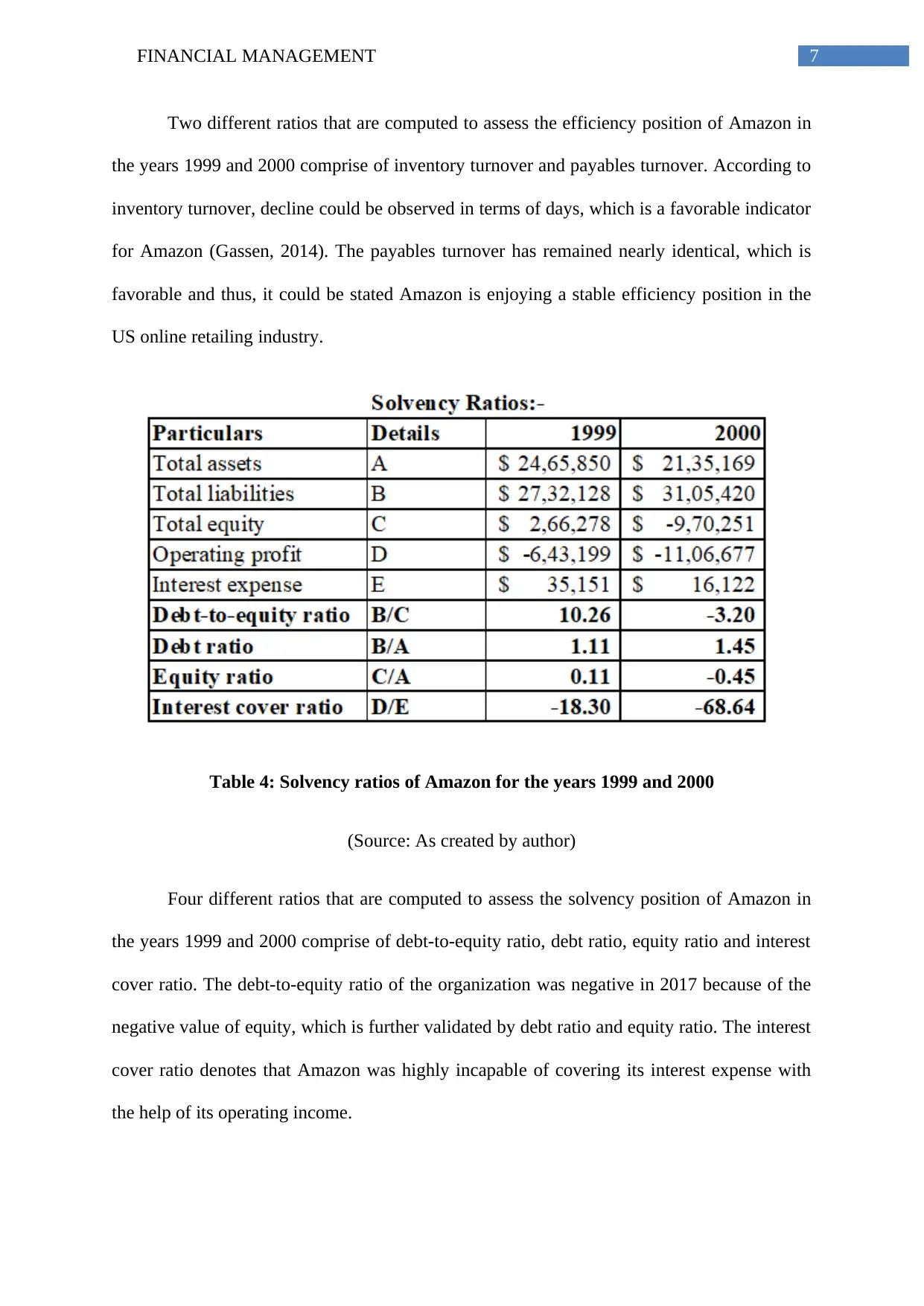
7FINANCIAL MANAGEMENT
Two different ratios that are computed to assess the efficiency position of Amazon in
the years 1999 and 2000 comprise of inventory turnover and payables turnover. According to
inventory turnover, decline could be observed in terms of days, which is a favorable indicator
for Amazon (Gassen, 2014). The payables turnover has remained nearly identical, which is
favorable and thus, it could be stated Amazon is enjoying a stable efficiency position in the
US online retailing industry.
Table 4: Solvency ratios of Amazon for the years 1999 and 2000
(Source: As created by author)
Four different ratios that are computed to assess the solvency position of Amazon in
the years 1999 and 2000 comprise of debt-to-equity ratio, debt ratio, equity ratio and interest
cover ratio. The debt-to-equity ratio of the organization was negative in 2017 because of the
negative value of equity, which is further validated by debt ratio and equity ratio. The interest
cover ratio denotes that Amazon was highly incapable of covering its interest expense with
the help of its operating income.
Two different ratios that are computed to assess the efficiency position of Amazon in
the years 1999 and 2000 comprise of inventory turnover and payables turnover. According to
inventory turnover, decline could be observed in terms of days, which is a favorable indicator
for Amazon (Gassen, 2014). The payables turnover has remained nearly identical, which is
favorable and thus, it could be stated Amazon is enjoying a stable efficiency position in the
US online retailing industry.
Table 4: Solvency ratios of Amazon for the years 1999 and 2000
(Source: As created by author)
Four different ratios that are computed to assess the solvency position of Amazon in
the years 1999 and 2000 comprise of debt-to-equity ratio, debt ratio, equity ratio and interest
cover ratio. The debt-to-equity ratio of the organization was negative in 2017 because of the
negative value of equity, which is further validated by debt ratio and equity ratio. The interest
cover ratio denotes that Amazon was highly incapable of covering its interest expense with
the help of its operating income.
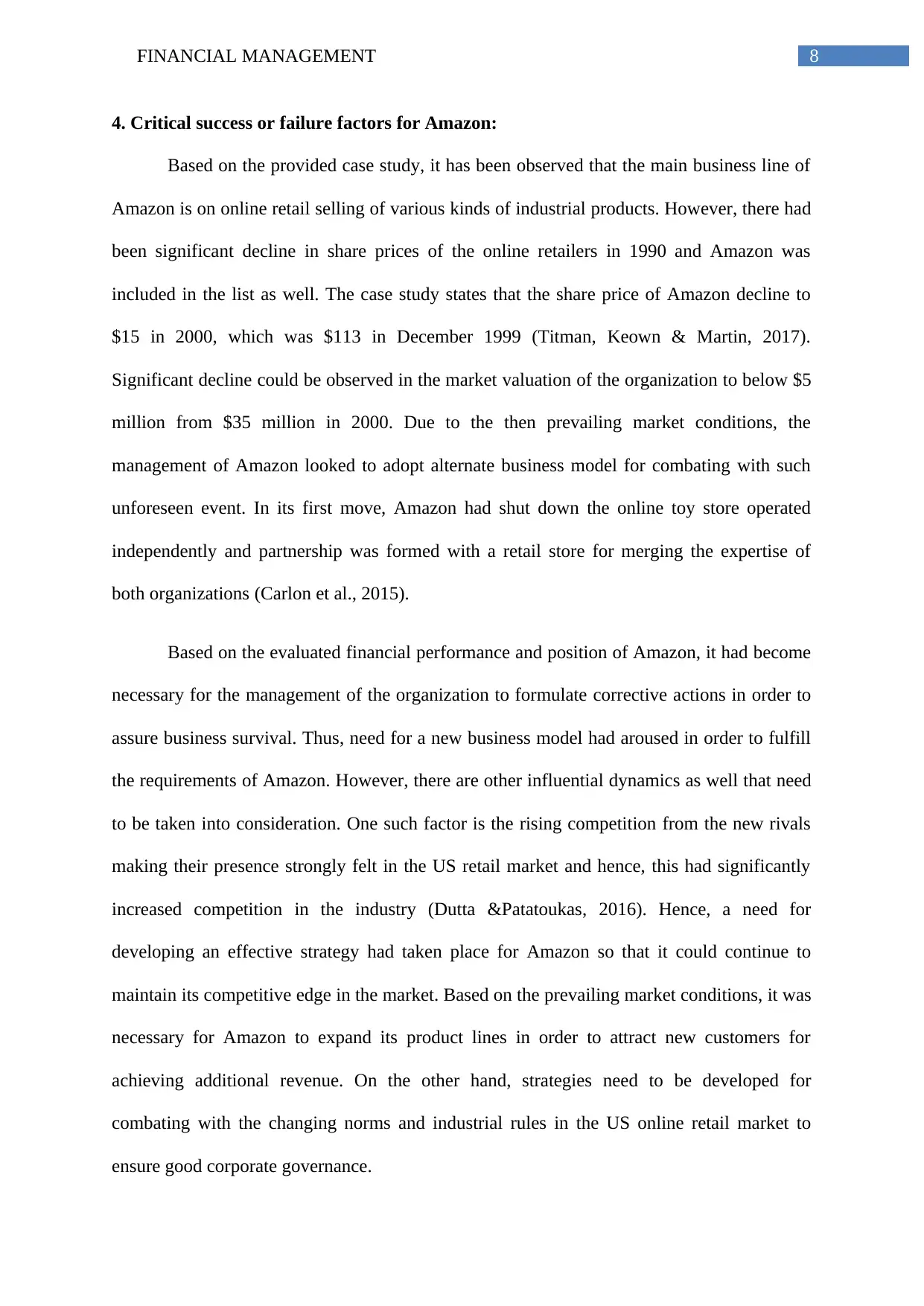
8FINANCIAL MANAGEMENT
4. Critical success or failure factors for Amazon:
Based on the provided case study, it has been observed that the main business line of
Amazon is on online retail selling of various kinds of industrial products. However, there had
been significant decline in share prices of the online retailers in 1990 and Amazon was
included in the list as well. The case study states that the share price of Amazon decline to
$15 in 2000, which was $113 in December 1999 (Titman, Keown & Martin, 2017).
Significant decline could be observed in the market valuation of the organization to below $5
million from $35 million in 2000. Due to the then prevailing market conditions, the
management of Amazon looked to adopt alternate business model for combating with such
unforeseen event. In its first move, Amazon had shut down the online toy store operated
independently and partnership was formed with a retail store for merging the expertise of
both organizations (Carlon et al., 2015).
Based on the evaluated financial performance and position of Amazon, it had become
necessary for the management of the organization to formulate corrective actions in order to
assure business survival. Thus, need for a new business model had aroused in order to fulfill
the requirements of Amazon. However, there are other influential dynamics as well that need
to be taken into consideration. One such factor is the rising competition from the new rivals
making their presence strongly felt in the US retail market and hence, this had significantly
increased competition in the industry (Dutta &Patatoukas, 2016). Hence, a need for
developing an effective strategy had taken place for Amazon so that it could continue to
maintain its competitive edge in the market. Based on the prevailing market conditions, it was
necessary for Amazon to expand its product lines in order to attract new customers for
achieving additional revenue. On the other hand, strategies need to be developed for
combating with the changing norms and industrial rules in the US online retail market to
ensure good corporate governance.
4. Critical success or failure factors for Amazon:
Based on the provided case study, it has been observed that the main business line of
Amazon is on online retail selling of various kinds of industrial products. However, there had
been significant decline in share prices of the online retailers in 1990 and Amazon was
included in the list as well. The case study states that the share price of Amazon decline to
$15 in 2000, which was $113 in December 1999 (Titman, Keown & Martin, 2017).
Significant decline could be observed in the market valuation of the organization to below $5
million from $35 million in 2000. Due to the then prevailing market conditions, the
management of Amazon looked to adopt alternate business model for combating with such
unforeseen event. In its first move, Amazon had shut down the online toy store operated
independently and partnership was formed with a retail store for merging the expertise of
both organizations (Carlon et al., 2015).
Based on the evaluated financial performance and position of Amazon, it had become
necessary for the management of the organization to formulate corrective actions in order to
assure business survival. Thus, need for a new business model had aroused in order to fulfill
the requirements of Amazon. However, there are other influential dynamics as well that need
to be taken into consideration. One such factor is the rising competition from the new rivals
making their presence strongly felt in the US retail market and hence, this had significantly
increased competition in the industry (Dutta &Patatoukas, 2016). Hence, a need for
developing an effective strategy had taken place for Amazon so that it could continue to
maintain its competitive edge in the market. Based on the prevailing market conditions, it was
necessary for Amazon to expand its product lines in order to attract new customers for
achieving additional revenue. On the other hand, strategies need to be developed for
combating with the changing norms and industrial rules in the US online retail market to
ensure good corporate governance.
⊘ This is a preview!⊘
Do you want full access?
Subscribe today to unlock all pages.

Trusted by 1+ million students worldwide
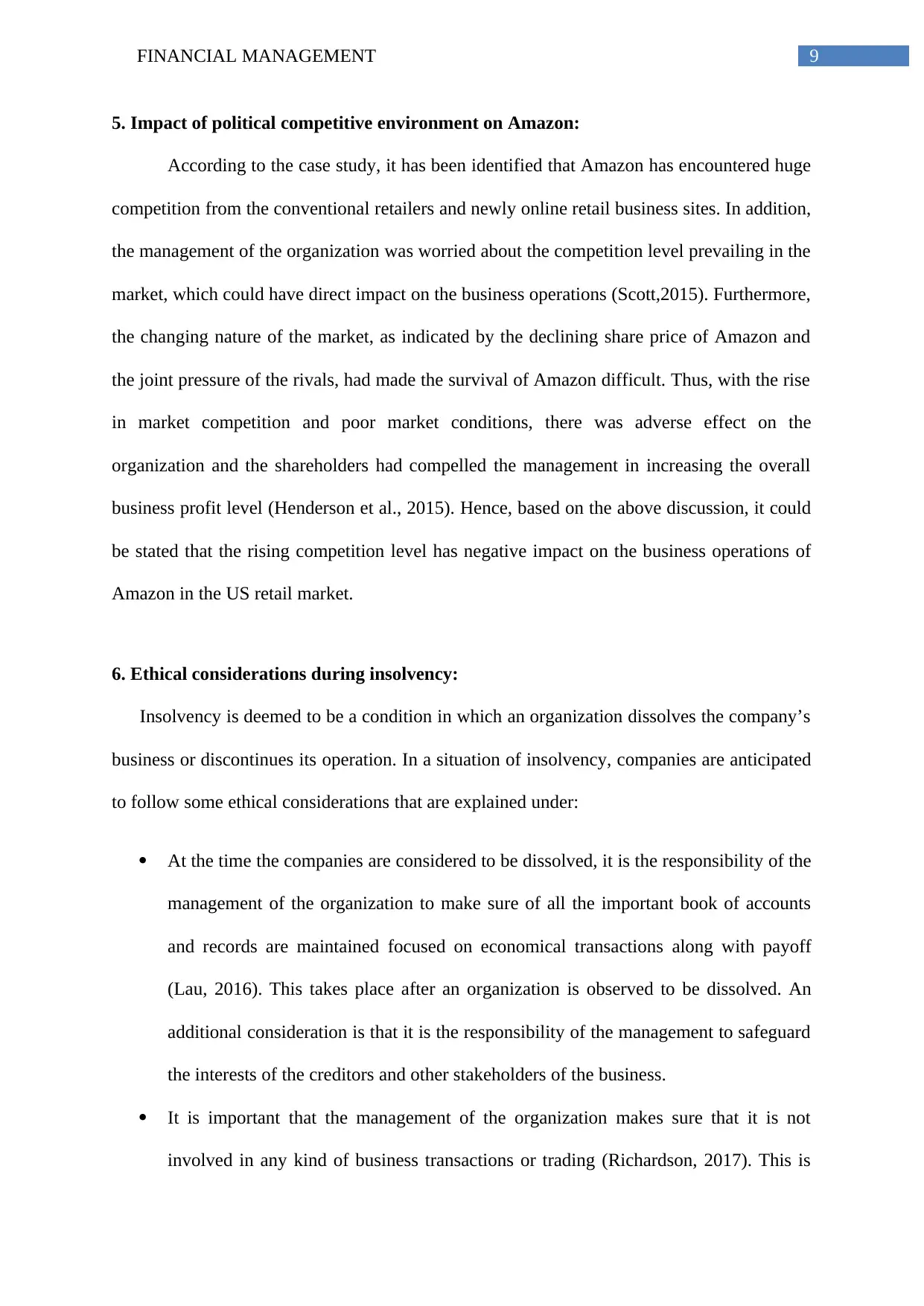
9FINANCIAL MANAGEMENT
5. Impact of political competitive environment on Amazon:
According to the case study, it has been identified that Amazon has encountered huge
competition from the conventional retailers and newly online retail business sites. In addition,
the management of the organization was worried about the competition level prevailing in the
market, which could have direct impact on the business operations (Scott,2015). Furthermore,
the changing nature of the market, as indicated by the declining share price of Amazon and
the joint pressure of the rivals, had made the survival of Amazon difficult. Thus, with the rise
in market competition and poor market conditions, there was adverse effect on the
organization and the shareholders had compelled the management in increasing the overall
business profit level (Henderson et al., 2015). Hence, based on the above discussion, it could
be stated that the rising competition level has negative impact on the business operations of
Amazon in the US retail market.
6. Ethical considerations during insolvency:
Insolvency is deemed to be a condition in which an organization dissolves the company’s
business or discontinues its operation. In a situation of insolvency, companies are anticipated
to follow some ethical considerations that are explained under:
At the time the companies are considered to be dissolved, it is the responsibility of the
management of the organization to make sure of all the important book of accounts
and records are maintained focused on economical transactions along with payoff
(Lau, 2016). This takes place after an organization is observed to be dissolved. An
additional consideration is that it is the responsibility of the management to safeguard
the interests of the creditors and other stakeholders of the business.
It is important that the management of the organization makes sure that it is not
involved in any kind of business transactions or trading (Richardson, 2017). This is
5. Impact of political competitive environment on Amazon:
According to the case study, it has been identified that Amazon has encountered huge
competition from the conventional retailers and newly online retail business sites. In addition,
the management of the organization was worried about the competition level prevailing in the
market, which could have direct impact on the business operations (Scott,2015). Furthermore,
the changing nature of the market, as indicated by the declining share price of Amazon and
the joint pressure of the rivals, had made the survival of Amazon difficult. Thus, with the rise
in market competition and poor market conditions, there was adverse effect on the
organization and the shareholders had compelled the management in increasing the overall
business profit level (Henderson et al., 2015). Hence, based on the above discussion, it could
be stated that the rising competition level has negative impact on the business operations of
Amazon in the US retail market.
6. Ethical considerations during insolvency:
Insolvency is deemed to be a condition in which an organization dissolves the company’s
business or discontinues its operation. In a situation of insolvency, companies are anticipated
to follow some ethical considerations that are explained under:
At the time the companies are considered to be dissolved, it is the responsibility of the
management of the organization to make sure of all the important book of accounts
and records are maintained focused on economical transactions along with payoff
(Lau, 2016). This takes place after an organization is observed to be dissolved. An
additional consideration is that it is the responsibility of the management to safeguard
the interests of the creditors and other stakeholders of the business.
It is important that the management of the organization makes sure that it is not
involved in any kind of business transactions or trading (Richardson, 2017). This is
Paraphrase This Document
Need a fresh take? Get an instant paraphrase of this document with our AI Paraphraser
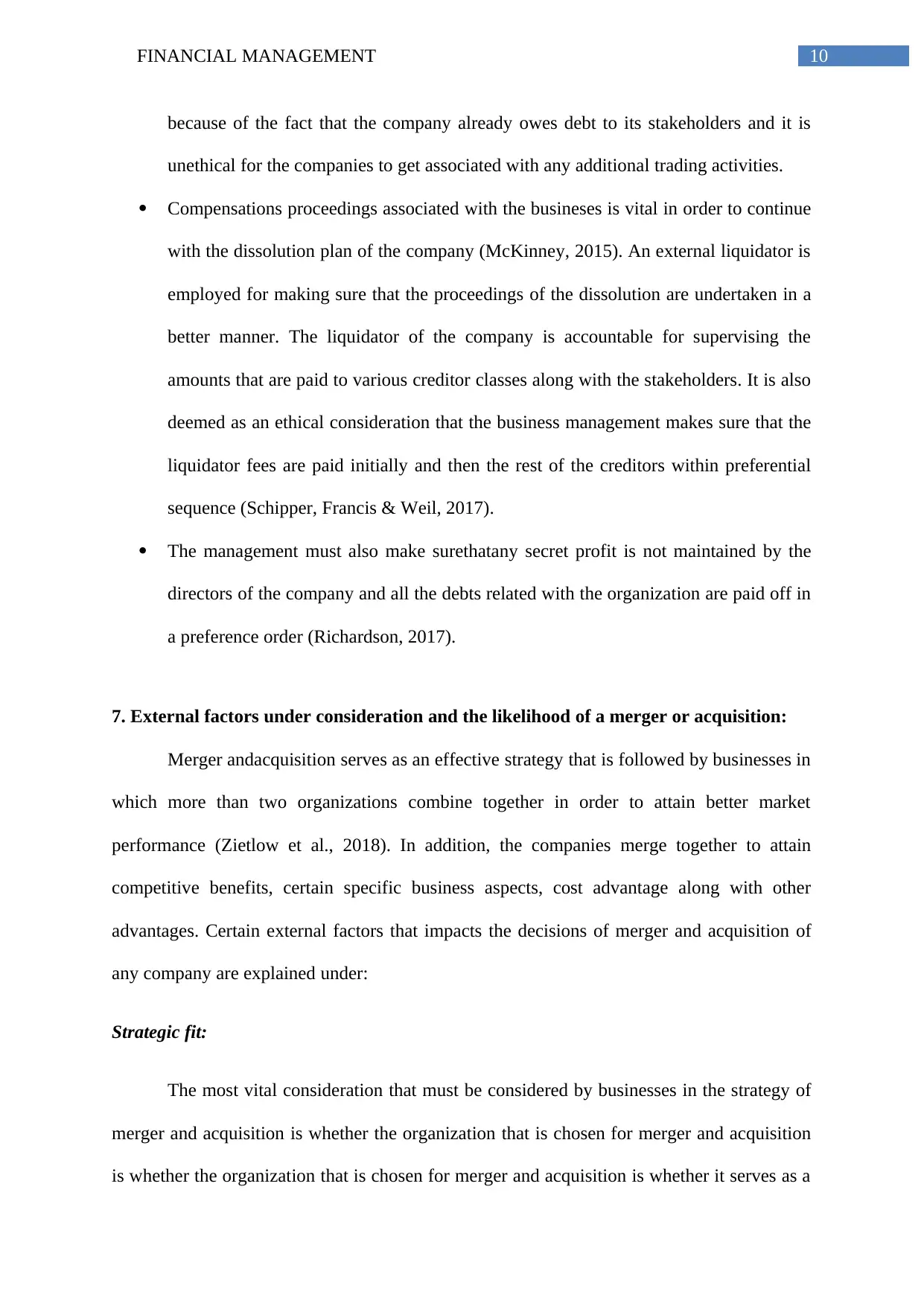
10FINANCIAL MANAGEMENT
because of the fact that the company already owes debt to its stakeholders and it is
unethical for the companies to get associated with any additional trading activities.
Compensations proceedings associated with the busineses is vital in order to continue
with the dissolution plan of the company (McKinney, 2015). An external liquidator is
employed for making sure that the proceedings of the dissolution are undertaken in a
better manner. The liquidator of the company is accountable for supervising the
amounts that are paid to various creditor classes along with the stakeholders. It is also
deemed as an ethical consideration that the business management makes sure that the
liquidator fees are paid initially and then the rest of the creditors within preferential
sequence (Schipper, Francis & Weil, 2017).
The management must also make surethatany secret profit is not maintained by the
directors of the company and all the debts related with the organization are paid off in
a preference order (Richardson, 2017).
7. External factors under consideration and the likelihood of a merger or acquisition:
Merger andacquisition serves as an effective strategy that is followed by businesses in
which more than two organizations combine together in order to attain better market
performance (Zietlow et al., 2018). In addition, the companies merge together to attain
competitive benefits, certain specific business aspects, cost advantage along with other
advantages. Certain external factors that impacts the decisions of merger and acquisition of
any company are explained under:
Strategic fit:
The most vital consideration that must be considered by businesses in the strategy of
merger and acquisition is whether the organization that is chosen for merger and acquisition
is whether the organization that is chosen for merger and acquisition is whether it serves as a
because of the fact that the company already owes debt to its stakeholders and it is
unethical for the companies to get associated with any additional trading activities.
Compensations proceedings associated with the busineses is vital in order to continue
with the dissolution plan of the company (McKinney, 2015). An external liquidator is
employed for making sure that the proceedings of the dissolution are undertaken in a
better manner. The liquidator of the company is accountable for supervising the
amounts that are paid to various creditor classes along with the stakeholders. It is also
deemed as an ethical consideration that the business management makes sure that the
liquidator fees are paid initially and then the rest of the creditors within preferential
sequence (Schipper, Francis & Weil, 2017).
The management must also make surethatany secret profit is not maintained by the
directors of the company and all the debts related with the organization are paid off in
a preference order (Richardson, 2017).
7. External factors under consideration and the likelihood of a merger or acquisition:
Merger andacquisition serves as an effective strategy that is followed by businesses in
which more than two organizations combine together in order to attain better market
performance (Zietlow et al., 2018). In addition, the companies merge together to attain
competitive benefits, certain specific business aspects, cost advantage along with other
advantages. Certain external factors that impacts the decisions of merger and acquisition of
any company are explained under:
Strategic fit:
The most vital consideration that must be considered by businesses in the strategy of
merger and acquisition is whether the organization that is chosen for merger and acquisition
is whether the organization that is chosen for merger and acquisition is whether it serves as a
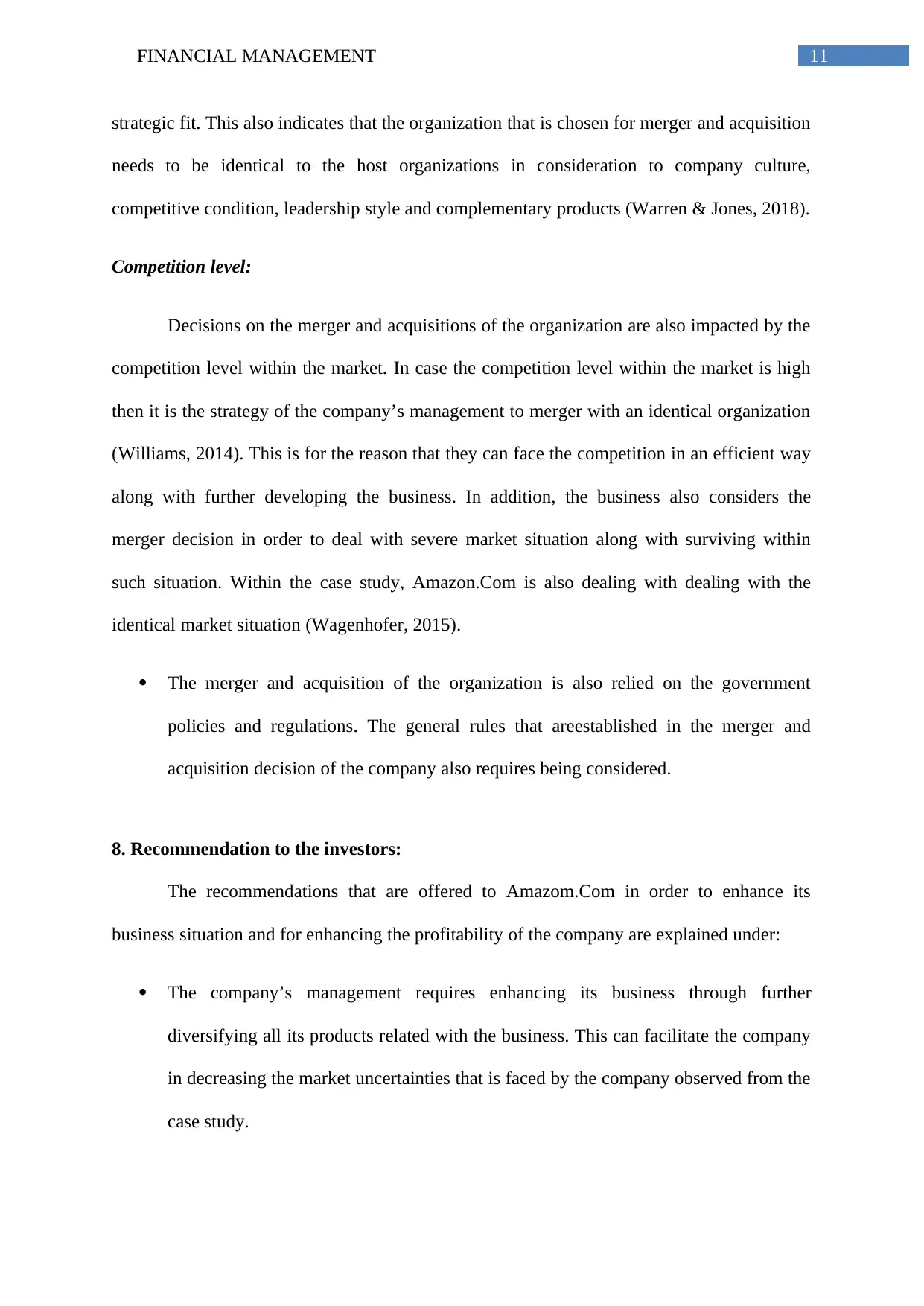
11FINANCIAL MANAGEMENT
strategic fit. This also indicates that the organization that is chosen for merger and acquisition
needs to be identical to the host organizations in consideration to company culture,
competitive condition, leadership style and complementary products (Warren & Jones, 2018).
Competition level:
Decisions on the merger and acquisitions of the organization are also impacted by the
competition level within the market. In case the competition level within the market is high
then it is the strategy of the company’s management to merger with an identical organization
(Williams, 2014). This is for the reason that they can face the competition in an efficient way
along with further developing the business. In addition, the business also considers the
merger decision in order to deal with severe market situation along with surviving within
such situation. Within the case study, Amazon.Com is also dealing with dealing with the
identical market situation (Wagenhofer, 2015).
The merger and acquisition of the organization is also relied on the government
policies and regulations. The general rules that areestablished in the merger and
acquisition decision of the company also requires being considered.
8. Recommendation to the investors:
The recommendations that are offered to Amazom.Com in order to enhance its
business situation and for enhancing the profitability of the company are explained under:
The company’s management requires enhancing its business through further
diversifying all its products related with the business. This can facilitate the company
in decreasing the market uncertainties that is faced by the company observed from the
case study.
strategic fit. This also indicates that the organization that is chosen for merger and acquisition
needs to be identical to the host organizations in consideration to company culture,
competitive condition, leadership style and complementary products (Warren & Jones, 2018).
Competition level:
Decisions on the merger and acquisitions of the organization are also impacted by the
competition level within the market. In case the competition level within the market is high
then it is the strategy of the company’s management to merger with an identical organization
(Williams, 2014). This is for the reason that they can face the competition in an efficient way
along with further developing the business. In addition, the business also considers the
merger decision in order to deal with severe market situation along with surviving within
such situation. Within the case study, Amazon.Com is also dealing with dealing with the
identical market situation (Wagenhofer, 2015).
The merger and acquisition of the organization is also relied on the government
policies and regulations. The general rules that areestablished in the merger and
acquisition decision of the company also requires being considered.
8. Recommendation to the investors:
The recommendations that are offered to Amazom.Com in order to enhance its
business situation and for enhancing the profitability of the company are explained under:
The company’s management requires enhancing its business through further
diversifying all its products related with the business. This can facilitate the company
in decreasing the market uncertainties that is faced by the company observed from the
case study.
⊘ This is a preview!⊘
Do you want full access?
Subscribe today to unlock all pages.

Trusted by 1+ million students worldwide
1 out of 17
Related Documents
Your All-in-One AI-Powered Toolkit for Academic Success.
+13062052269
info@desklib.com
Available 24*7 on WhatsApp / Email
![[object Object]](/_next/static/media/star-bottom.7253800d.svg)
Unlock your academic potential
Copyright © 2020–2025 A2Z Services. All Rights Reserved. Developed and managed by ZUCOL.





